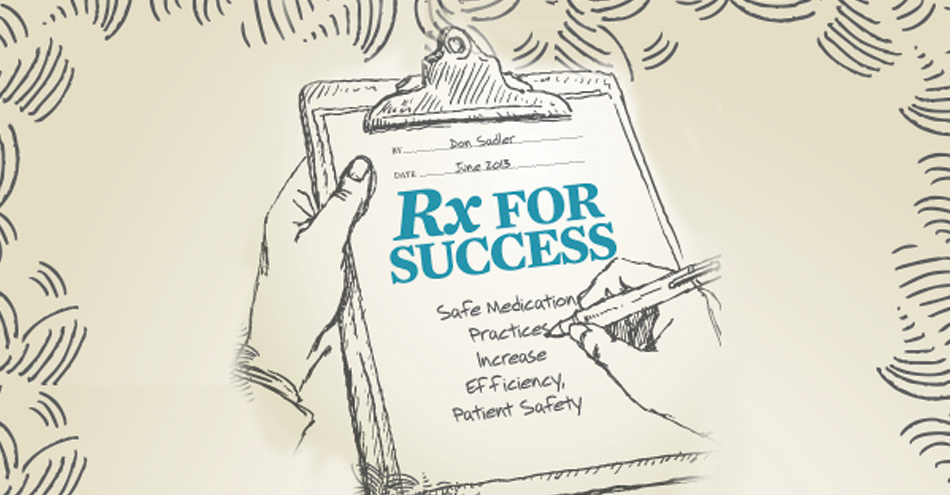Rx for Success: Safe Medication Practices Increase Efficiency, Patient Safety
by Don Sadler
Many perioperative nurses say that patient safety is their highest priority in the OR. This extends beyond safe surgical practices to include safe medication practices as well.
In recognition of nurses’ concern over medication safety, the Association of periOperative Registered Nurses (AORN) released “Recommended practices for medication safety” in January of last year. AORN noted that medication safety has become increasingly important as state and federal inspections are focusing on safe injection practices, while accreditation organizations focus on national goals aimed at reducing medication errors.
“Recommended practices for medication safety” outlines best practices for all six phases of medication use: procuring, prescribing, transcribing, dispensing, administering and monitoring. It expands the description of medication safety by looking at broader risk points in the life of a medication, and includes a multidisciplinary approach that can be used by all members of the perioperative team in all perioperative practice settings.
A complex topic
“Medication safety is a complex topic,” says AORN Perioperative Nursing Specialist Bonnie G. Denholm, MS, BSN, RN, CNOR. “When we drafted out the scope of the new recommended practices, our goal was to cover the important key points and present the related evidence or regulations so the document will hold up over time.”
Denholm says that the AORN “Recommended practices for medication safety” address 10 key points:
- Labeling medications that are removed from the original container
- Medication reconciliation
- Handling hazardous medications
- Pharmaceutical waste
- Drug diversion
- Safe injection practices
- Compounding medications
- Incorporating the full picture with the medication use process (including procurement and storage)
- Pharmacy involvement
- Discharge planning and education
“Out of these key points, the three that get the most attention from state and federal facility inspections are safe injection practices, labeling medications and medication storage,” she notes. “Facility inspectors from health departments and accreditation organizations are concerned about the potential for cross contamination. They are looking for needles and syringes to be used only one time when administering medications and then disposed of safely using sharp safety practices.”
Denholm acknowledges that a challenge with the one-needle, one-syringe concept when working with medications on the sterile field is when the surgical or invasive procedure involves incremental doses of a local anesthetic at the surgical site. “We collaborated with colleagues from the CDC and APIC to come up with a recommendation that allows the same syringe and needle to be reused for the same patient as part of a single procedure, as long as there is compliance with strict aseptic technique.”
Another area inspectors focus on is single-dose versus multidose vials. “Whenever possible, single dose vials should be ordered,” Denholm stresses. “When multi-dose vials are used, the inspectors will focus on beyond-use dates that should be written on the vials when they are opened.”
Potential controversies
When the recommended practices were released last January, AORN acknowledged that some of them might be controversial. These included the recommendation that intravenous solution containers be punctured as close as possible to the time of use, and the recommendation against the use of multi-dose vials. Both of these practices can increase efficiency and save money for hospitals.
“We had already started to get away from using multi-dose vials before the recommended practices were released, and now we don’t use them in the OR at all,” says Ruth Nelson-Mustard, RN, BSN, the OR director for Rex Healthcare in Raleigh, N.C.
“Cost savings are nice, but they’re not worth the risk of infection or contamination.”
Cindy Tudor, RN, the clinical director for Community Surgery Center Howard in Kokomo, Ind., says she originally wasn’t aware of the recommendation that intravenous solution containers be punctured as close as possible to time of use. When informed about the recommended practice, she posted a question about it to the OR Nation (www.theornation.com).
“We used to assemble the IVs the evening before and put the assembled IV kits in a drawer for use the next day,” says Tudor. “But then I was told they could only be spiked an hour before use. Once we found out about the recommended practice, we changed our practice and no longer puncture IV bags early. It does affect efficiency during patient admissions — we can no longer have this done ahead of time to save a step during the admission process.”
In January, Rex Healthcare implemented new medication procedures in which a pharmacy technician is now present in the OR to dispense all medications based on the preference list. “Medication is no longer stored in OR storage rooms, and all medications are dispensed through automated dispensing machines by the pharmacy technician,” says Nelson-Mustard. “This helps reduce medication expiration and recall risk.”
Denholm says AORN has not received a lot of feedback from perioperative nurses regarding the recommendation to prepare medications as close as possible to the time of use, which includes not spiking IV solutions ahead of time. “And we have made efforts to clarify the importance of reducing the use of multi-dose injection vials and identifying an expiration date on over-the-counter medications and elixers that are kept in medication storage areas.”
But she says AORN has received feedback regarding single-dose versus multi-dose vials as it relates to drug shortages. “In 2012, clarification came from the Centers for Medicare and Medicaid Services and the Centers for Disease Control and Prevention that unopened single-dose vials can be repackaged into multiple smaller doses if the repackaging is done in accordance with USP 797,” says Denholm.
In addition, she says AORN has heard from some OR nurses that it is more convenient to remove the rubber stoppers from medication vials and pour the solution onto the sterile field. “We know that some healthcare organizations do not have sterile transfer devices readily available for transferring medications to the sterile field. However, this practice increases the risk for contamination to occur.
“If a sterile transfer device is not available, a syringe and needle can be used to withdraw the medication and transfer it to the sterile field. If possible, a blunt-tipped needle should be used to comply with sharp safety practices.”
The medication use process
Denholm points out that the “Recommended practices for medication safety” were expanded to include not just medications themselves, but the broader medication use process. “By doing so, we were able to highlight actions that can be taken to reduce risk before the time of administration. These actions include proper storage to reduce confusion, avoiding verbal medication orders, and pharmacy involvement to detect errors, contraindications and drug-to-drug interactions.”
“Pharmacy oversight and involvement in the medication use process in the perioperative setting is very important,” concurs Jane Green, the pharmacy director for Rex Hospital. “Pharmacy technicians are trained in how medications work and how they’re dosed, and they can provide valuable input regarding specific medication use in certain types of surgical cases.
“The medication safety recommended practices from AORN are very comprehensive best practices that are designed to keep patient safety top of mind at all times,” she adds.
“I believe these recommended practices have definitely helped improve medication safety,” says Nelson-Mustard. “Many hospitals were already practicing most of them, but anytime they’re brought to the forefront like this, it serves as a good reminder and people become more engaged in following them more closely.”










